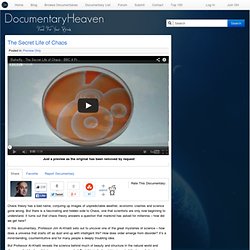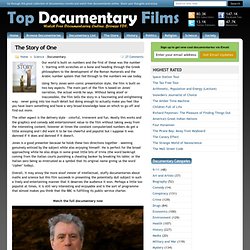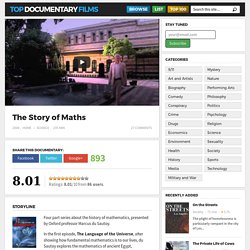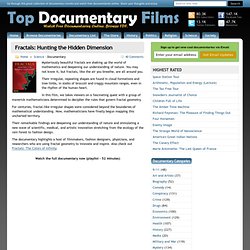

Watch Free Documentary Online. Chaos theory has a bad name, conjuring up images of unpredictable weather, economic crashes and science gone wrong.

But there is a fascinating and hidden side to Chaos, one that scientists are only now beginning to understand. It turns out that chaos theory answers a question that mankind has asked for millennia – how did we get here? In this documentary, Professor Jim Al-Khalili sets out to uncover one of the great mysteries of science – how does a universe that starts off as dust end up with intelligent life? How does order emerge from disorder? It’s a mind-bending, counterintuitive and for many people a deeply troubling idea. Watch Free Documentary Online. Dimensions: A Walk Through Mathematics. A film for a wide audience!

Nine chapters, two hours of maths, that take you gradually up to the fourth dimension. Mathematical vertigo guaranteed! Dimension Two - Hipparchus shows us how to describe the position of any point on Earth with two numbers... and explains the stereographic projection: how to draw a map of the world. Dimension Three - M.C. Escher talks about the adventures of two-dimensional creatures trying to imagine what three-dimensional objects look like. The Fourth Dimension - Mathematician Ludwig Schläfli talks about objects that live in the fourth dimension... and shows a parade of four-dimensional polytopes, strange objects with 24, 120 and even 600 faces!
Complex Numbers - Mathematician Adrien Douady explains complex numbers. Fibration - Mathematician Heinz Hopf explains his "fibration". The Story of One. Our world is built on numbers and the first of these was the number 1.

Starting with scratches on a bone and heading through the Greek philosophers to the development of the Roman Numerals and the Arabic number system that fed through to the numbers we use today. Using Terry Jones semi-comic presentation style, the film is built on two key aspects. The main part of the film is based on Jones' narration, the actual words he says. Without being aloof or inaccessible, the film tells the story in a fascinating and enlightening way – never going into too much detail but doing enough to actually make you feel like you have learn something and have a very broad knowledge base on which to go off and find out more. The Story of Maths. Four part series about the history of mathematics, presented by Oxford professor Marcus du Sautoy.

In the first episode, The Language of the Universe, after showing how fundamental mathematics is to our lives, du Sautoy explores the mathematics of ancient Egypt, Mesopotamia and Greece. In Egypt, he uncovers use of a decimal system based on ten fingers of the hand, while in former Mesopotamia he discovers that the way we tell the time today is based on the Babylonian Base 60 number system. In Greece, he looks at the contributions of some of the giants of mathematics including Plato, Euclid, Archimedes and Pythagoras, who is credited with beginning the transformation of mathematics from a tool for counting into the analytical subject we know today.
The second episode, The Genius of the East, sees du Sautoy leaving the ancient world. When ancient Greece fell into decline, mathematical progress stagnated as Europe entered the Dark Ages, but in the East mathematics reached new heights. Fermat’s Last Theorem. Simon Singh and John Lynch’s film tells the enthralling and emotional story of Andrew Wiles.

A quiet English mathematician, he was drawn into maths by Fermat’s puzzle, but at Cambridge in the ’70s, FLT was considered a joke, so he set it aside. Then, in 1986, an extraordinary idea linked this irritating problem with one of the most profound ideas of modern mathematics: the Taniyama-Shimura Conjecture, named after a young Japanese mathematician who tragically committed suicide. The link meant that if Taniyama was true then so must be FLT. When he heard, Wiles went after his childhood dream again. “I knew that the course of my life was changing.” In June 1993 he reached his goal. Fractals: Hunting the Hidden Dimension. Mysteriously beautiful fractals are shaking up the world of mathematics and deepening our understanding of nature.

You may not know it, but fractals, like the air you breathe, are all around you. Their irregular, repeating shapes are found in cloud formations and tree limbs, in stalks of broccoli and craggy mountain ranges, even in the rhythm of the human heart. In this film, we takes viewers on a fascinating quest with a group of maverick mathematicians determined to decipher the rules that govern fractal geometry. For centuries, fractal-like irregular shapes were considered beyond the boundaries of mathematical understanding. Now, mathematicians have finally begun mapping this uncharted territory. Fractals: The Colors of Infinity. The Mandelbrot set - someone has called it the thumb-print of God - is one of the most beautiful and remarkable discoveries in the entire history of mathematics.

With Arthur C. Clarke as narrator and interviews with a number of notable mathematicians, including Benoît Mandelbrot, this program graphically illustrates how simple formulas can lead to complicated results: it explains the set, what it means, its internal consistency, and the revolutions in thought resulting from its discovery. Asked if the real universe goes on forever, Stephen Hawking defines its limit of smallness; the Mandelbrot set, on the other hand, may go on forever. The invention of the silicon chip in the 1970's created a revolution in computers and communication and hence transformed our way of life. We are now seeing another revolution which is going to change our view of the universe and give us a better understanding of its' working.